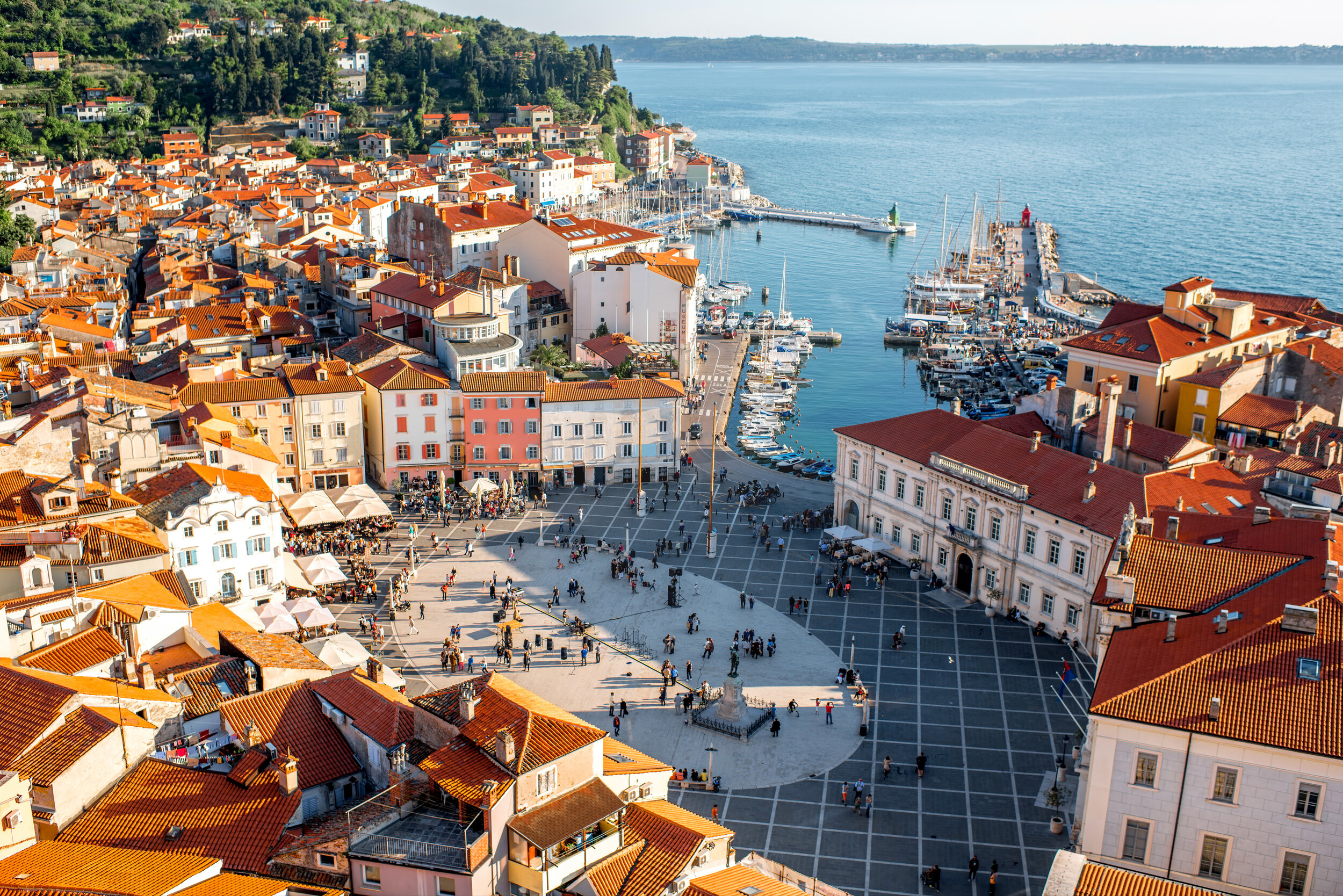17: Piran // The Petals Are Running Out
A beautiful aerial shot of Piran, Slovenia // © Luka Zelko / Shutterstock
Before the church I meandered along the water’s edge, veering between taking in the imposing eternity of the sea itself and the quaint promise of Piran’s elongated centre. A lonesome statue of a mermaid stood on its edge, gazing towards that famous epitome of absolute loneliness; the lighthouse. I ventured in, I ventured up, rewarded with a pleasant view and a developed appreciation for the life of a lighthouse keeper.
Onwards, through the narrow streets of Piran, past tired buildings enhanced by filters and photo editing, towards the Church of St George, itself a lonesome image in a crowded town. The church is the life’s work of an otherwise forgotten stonemason from Venice called Bonfante Torre, a name that barely draws a whisper from the abyss of history, but remains eternal in the walls of Piran’s central church. The church itself drew little impression, no disrespect to Torre, but Piran is a city viewed from above and any opportunity to do so will take precedent over churches, cathedrals, tombs and monasteries. The church’s bell tower loomed large, promising the ultimate view of the city.
146 steps and 15 angle-inspired landings later, that view spread out in front of me. Constructed at the very beginning of the 17th century, the bell at its heart was even older, a 1477 creation that clanged every hour. All useful information I’m sure, but the view of its city was undoubtedly the reward for clambering up the steps and the deep breaths. The red roofs of Piran glimmered somewhere between copper and bronze, a tired hue of experience and charm that sings universal. Piran’s shape is unique, a primed arm that stretches to the sea before pulling back at the last second, allowing the Adriatic to take over. All poetic meanderings aside, it is bloody beautiful.
Tartini Square in Piran, Slovenia // © RossHelen / shutterstock
I wasn’t alone at the top of the bell tower, you rarely are alone in Piran, and gasping couples enjoyed the same view as I. One young couple was filming something, a video about identifying serenity in stressful positions. The girl was the star, talking about the importance of taking stock of your surroundings and focusing on that which provides tranquillity. The sea, let the sea in. Once you’ve embraced that, think about what you can hear, a sentence interrupted by a panicked shriek.
The sentence wasn’t necessarily interrupted by the shriek, as the shriek was dragged out of the girl by the deafening bong of the 15th-century church bell. There are few sounds as arresting as the church bell, a smashing barrage that exists with the sole intention of attracting believers from far away, letting the distant know that the time for prayer has arrived. You can hear the bells of St George from miles away, but stood directly next to them creates a cacophony that drowns out all else. The girl’s shriek was one of many, among them my own strangled cry. It was time to head back down to street-level.
The beauty of Piran isn’t quite as flawless as the pictures suggest, as the facade hints. The red roofs are as idyllic as a collection of tiled surfaces can get, and the views that extend around Tartini Square are a perfect visage of coastal existence. This is all picture-perfect, but wander the back streets of the old town and a different picture unfolds.
Many of the buildings in Piran are in a dilapidated state, owned by people who have no interest in selling them and even less in looking after them. This isn’t ubiquitous, far from it, but I came across more than enough degradation while wandering the streets for the visage to crack. This wasn’t the faded glamour of Izola, the vibrant-turned-pastel of Koper. This was pure, unadulterated neglect.
One building caught my eye, a largely nondescript yellow construction on First of May Square. Chunks of paint were missing from the facade, exposing tired material and a worn soul that may well have been Piran itself, creaking under the pressure of expectation and tourism combined. Four rows of three shutters apiece continued the theme, a dizzying range of the unappreciated and the beloved, fresh blue all the way to rotting wood. A nearby red tower building continued the theme, diseased crimson accentuated by green shutters, the majority of the windows smashed.
A postcard of Piran from 1911 // © WikiMedia Commons
And the penny drops. Piran is absolutely gorgeous, of course, it is, but it is a beauty that sheds another layer of authenticity with every passing year, a beauty that comes with a price. The petals are running out. If it isn’t already, the picturesque village on the Adriatic that many claim to be Slovenia’s most beautiful town will become an ugly reminder of the dangers of tourism, as prices rise and ordinary existence is pushed out. The restaurants identikit, the cafes the same, aesthetics prioritised over character with total disregard for the hammer and tongs of time. From above, Piran is perfection, but down below the rats of time are filling their boots.
But there is always the sea, always the sea. If there is one thing resort towns will always have, it is the eternal tranquillity of a mass of water, the tender peace of the sea. Piran’s buildings will continue to fall apart one by one, as the outer ring is touched up with increasing desperation, but the glimmering hope of the sea will always keep it afloat.


